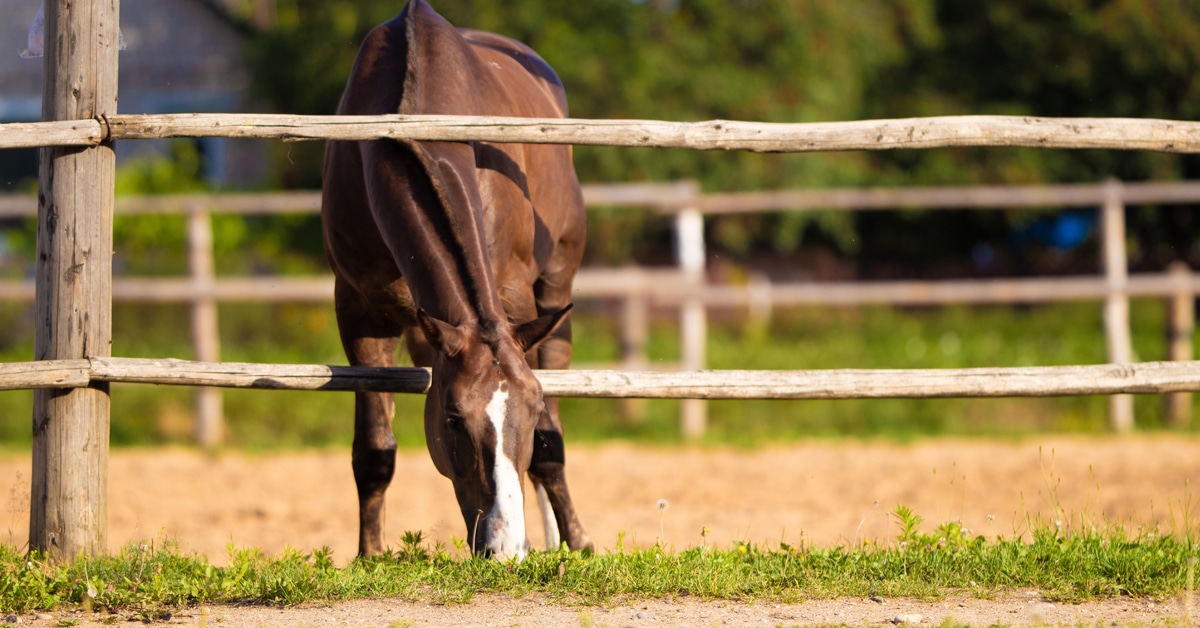Besides the obvious, such as never using barbed wire, high-tensile steel cattle wire, or page wire fence to contain horses, here are some common fencing mistakes and how to prevent them:
Poor planning: Before you begin, carefully map out your intended paddock area, making absolutely sure you know where the buried utilities and property lines are located. Consider other factors such as seasonal flood water levels and soil conditions both on the surface and 3′ below it.
Inappropriate fencing for type of horse: Stallions, for instance, require more robust fencing than a herd of quiet geldings or broodmares and foals. “I see a lot of people using the wrong fences for horses generally,” says Dain Rakestraw, marketing manager for Red Brand. “High-tensile smooth wire cattle fencing, barbed wire, wooden posts that are too small or too far apart, are all not suitable.”
Poor visibility: While tightly-woven square, v-mesh or diamond wire mesh makes good horse fencing, it can be hard to see. Installing a highly visible “sight board” across the top will prevent horses from running into it or bowing the top down. If you plan to use polymer strand fencing and live in a snowy region, consider alternating white and black strands for better visibility in all seasons. “It is a great idea, and it actually looks really nice,” says Lisa McCarl, president of US operations for Ag-Liner, Inc., who distribute Bayco Finish-Line.
Installing rails outside of posts: While more aesthetically pleasing when viewed from outside the paddock, wood rails can become loose if horses are constantly leaning on them. Again, install electric tape to deter leaning. “Maintenance is another factor that should be considered when making fencing decisions,” says McCarl, who points out that some fence materials require a lot of time-consuming upkeep.
Going cheap: Trying to save money by using fewer posts – whether you are installing wood, electric, vinyl/polymer or mesh – will lead to sagging, dangerous fences. “You are containing really expensive investments,” says McCarl, who also warns that the sun really takes a toll, so make sure vinyl or polymer materials have UV inhibitors. And don’t forget sufficient corner bracing, “the most important thing to any fence,” says Rakestraw.
Poor gate placement: Do not position gates too far from the barn, too close to another structure to allow safe passage, or build the openings too narrow to allow machinery in.
Uncovered metal t-posts: While providing an inexpensive and labour-saving way to set up enclosures using electric tape/rope, for example, if the tops are left uncovered they can present a hazard. Install inexpensive plastic caps.
Neglected electric fences: Whether you use electric fencing on its own or to protect wooden fencing, it should be inspected and tested regularly to make sure it is properly charged and grounded (and turned on!). Fallen tree branches, tall weeds and other materials touching the fence can compromise the charge and must be cleared away. McCarl recommends using electric in conjunction with all other fence types, for both safety and longevity. “Electric trains them off it.”
High-traffic areas: If horses have proximity to each other across fencelines they can play, which is hard on the fence and invites injury. Either rotate the turnout so that adjoining pastures are not used at the same time, or install electric fencing to deter interaction.
No “sacrifice” paddock: It is always advisable to create a smaller paddock for isolating ill or injured horses, or to save the footing in the main paddocks when the weather is sloppy.
No matter what fencing you choose, inspect it regularly. Wooden posts and boards can rot or break, wire can stretch, electric fencing can become ineffective. Horses are like kids; if there’s trouble to get into, they will find it. Make sure your fencing is not to blame.

